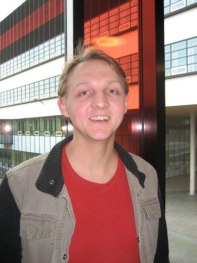Single-order Lamellar multilayer gratings
Promotion date: March 22.
Promotor: Prof.dr.ir. Fred Bijkerk
Assistant promotor: Prof.dr. Klaus Boller
| A major challenge in the soft x-ray (SXR) and eXtreme UV (XUV) spectral ranges, is the ability to manipulate the incident radiation using optical elements. Multilayer mirrors for these spectral ranges do exist, but they act as plane, reflective elements only. By patterning conventional multilayer mirrors with nanoscale structures, a next group of optical elements with a variety of new optical properties can be obtained. An important example are Lamellar Multilayer Gratings (LMG), which can be used to improve the spectral resolution of x-ray fluorescence spectroscopy. Although the LMG concept has long been known, the implementation of LMGs has been hampered by two critical challenges. The first being serious limitations in existing simulation methods, which provided limited insights in LMG operating principles and could only be used for idealized structures. The second challenge was the lack of a reproducible fabrication method with accurate dimension control for LMGs with grating periods well below 1 µm. The author has addressed both topics in his thesis. He derived a Coupled Waves Analysis (CWA) to simulate reflection and diffraction from LMGs. From this CWA, an optimal operating regime was identified, referred to as the single-order regime. He also developed a reproducible fabrication process, based on UV-NanoImprint Lithography and Bosch Deep Reactive Ion Etching, for single-order LMGs with grating periods down to record values of 200 nm. These LMGs achieved spectral resolutions of up to 330, to be compared with values of only 70 for conventional multilayer mirrors. This study can be considered as a pilot case for other optical elements that combine diffractive optics with Bragg reflection from multilayer mirrors. This opens up the route to many new short-wavelength optical applications, a topic that will be addressed in a new research group at the MESA+ Institute for Nanotechnology, headed by prof. Fred Bijkerk. |
Was your project application driven?
The research was indeed application driven, though fundamental aspects of course also arose along the way. In this research we studied novel optical elements called single-order lamellar multilayer gratings that can be used to improve elemental analysis of materials, which is of interest for example for aluminium producers. Similar elements could also be of interest for ASML or for soft x-ray beamlines, for the imaging of biological structures.
In the optical ranges under study, mirrors and lenses act fundamentally different from their more known counterparts in the visible light ranges. In the soft x-ray range, the material contrasts that can be obtained are much smaller and the x-ray beams are much more rapidly absorbed.
We succeeded in simulating and finally also producing single-order lamellar multilayer gratings. Imagine: up to eight hundred individual layers, of roughly only 1 nm each, are stacked on top of each other. Every layer reflects a part of the ‘light’, but also absorbs some of it. In such a multilayer mirror, we needed to accurately and reproducibly fabricate gratings with periods down to 200 nm. Analysing, simulating and producing these structures – together with specialised companies - was an exciting piece of work.
Were there some special moments that you recall during your thesis project?
By discovering the single-order regime, we were sure we had found something new. From that moment, our research strategy and simulations were directed to this immediately. We were able to publish results in a quite early stage already, giving us the opportunity to produce the high performance structures and characterize them. The reflection measurements in the end, served as a confirmation of the special performance these structures can achieve.
In what professional journals did you publish your results?
Three were published already in journals such as Optics Express and AIP Advances. In a few other publications I was a co-author. I also presented my work via oral presentations and posters at several international conferences.
What are your future plans?
As a researcher I am more of an experimentalist, but I also like the organisational aspects of my work. Eventually I aspire to work in industry, preferably in a function combining research, organisational and teamwork. I would also appreciate to contribute to society as I am an engaged person. For example I volunteer as a Red Cross representative in various health and sports events taking place.
For the next year I'm going to use the expertise I've obtained during my PhD, to help kick-start the new XUV Optics Industrial Focus Group, headed by thesis supervisor professor Fred Bijkerk. This is a group that will be moving to Twente in the course of this year, planning to explore more short wavelength optical applications based on the combination of diffractive optics and multilayer mirror Bragg reflection. I am very much convinced that such intermediate work can contribute significantly and I also believe this job suits me very well. Both in my master and in my PhD project I have enjoyed initiative, organizational tasks and arranging the contacts. The experimental results on LMGs were very rewarding!

